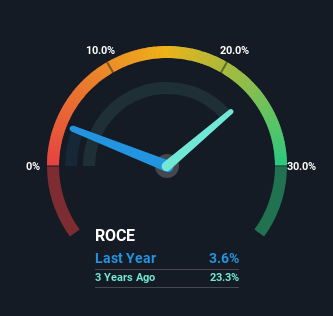- China
- /
- Electronic Equipment and Components
- /
- SZSE:300701
Here's What's Concerning About Senba Sensing TechnologyLtd's (SZSE:300701) Returns On Capital
If you're looking for a multi-bagger, there's a few things to keep an eye out for. Firstly, we'll want to see a proven return on capital employed (ROCE) that is increasing, and secondly, an expanding base of capital employed. If you see this, it typically means it's a company with a great business model and plenty of profitable reinvestment opportunities. Although, when we looked at Senba Sensing TechnologyLtd (SZSE:300701), it didn't seem to tick all of these boxes.
What Is Return On Capital Employed (ROCE)?
For those who don't know, ROCE is a measure of a company's yearly pre-tax profit (its return), relative to the capital employed in the business. The formula for this calculation on Senba Sensing TechnologyLtd is:
Return on Capital Employed = Earnings Before Interest and Tax (EBIT) ÷ (Total Assets - Current Liabilities)
0.036 = CN¥37m ÷ (CN¥1.2b - CN¥226m) (Based on the trailing twelve months to March 2024).
So, Senba Sensing TechnologyLtd has an ROCE of 3.6%. In absolute terms, that's a low return and it also under-performs the Electronic industry average of 5.2%.
See our latest analysis for Senba Sensing TechnologyLtd

Historical performance is a great place to start when researching a stock so above you can see the gauge for Senba Sensing TechnologyLtd's ROCE against it's prior returns. If you're interested in investigating Senba Sensing TechnologyLtd's past further, check out this free graph covering Senba Sensing TechnologyLtd's past earnings, revenue and cash flow.
What Does the ROCE Trend For Senba Sensing TechnologyLtd Tell Us?
The trend of ROCE doesn't look fantastic because it's fallen from 13% five years ago, while the business's capital employed increased by 105%. Usually this isn't ideal, but given Senba Sensing TechnologyLtd conducted a capital raising before their most recent earnings announcement, that would've likely contributed, at least partially, to the increased capital employed figure. It's unlikely that all of the funds raised have been put to work yet, so as a consequence Senba Sensing TechnologyLtd might not have received a full period of earnings contribution from it. It's also worth noting the company's latest EBIT figure is within 10% of the previous year, so it's fair to assign the ROCE drop largely to the capital raise.
On a side note, Senba Sensing TechnologyLtd's current liabilities have increased over the last five years to 18% of total assets, effectively distorting the ROCE to some degree. Without this increase, it's likely that ROCE would be even lower than 3.6%. Keep an eye on this ratio, because the business could encounter some new risks if this metric gets too high.
What We Can Learn From Senba Sensing TechnologyLtd's ROCE
Even though returns on capital have fallen in the short term, we find it promising that revenue and capital employed have both increased for Senba Sensing TechnologyLtd. However, despite the promising trends, the stock has fallen 30% over the last five years, so there might be an opportunity here for astute investors. So we think it'd be worthwhile to look further into this stock given the trends look encouraging.
Senba Sensing TechnologyLtd does come with some risks though, we found 4 warning signs in our investment analysis, and 1 of those is potentially serious...
If you want to search for solid companies with great earnings, check out this free list of companies with good balance sheets and impressive returns on equity.
Mobile Infrastructure for Defense and Disaster
The next wave in robotics isn't humanoid. Its fully autonomous towers delivering 5G, ISR, and radar in under 30 minutes, anywhere.
Get the investor briefing before the next round of contracts
Sponsored On Behalf of CiTechNew: Manage All Your Stock Portfolios in One Place
We've created the ultimate portfolio companion for stock investors, and it's free.
• Connect an unlimited number of Portfolios and see your total in one currency
• Be alerted to new Warning Signs or Risks via email or mobile
• Track the Fair Value of your stocks
Have feedback on this article? Concerned about the content? Get in touch with us directly. Alternatively, email editorial-team (at) simplywallst.com.
This article by Simply Wall St is general in nature. We provide commentary based on historical data and analyst forecasts only using an unbiased methodology and our articles are not intended to be financial advice. It does not constitute a recommendation to buy or sell any stock, and does not take account of your objectives, or your financial situation. We aim to bring you long-term focused analysis driven by fundamental data. Note that our analysis may not factor in the latest price-sensitive company announcements or qualitative material. Simply Wall St has no position in any stocks mentioned.
About SZSE:300701
Senba Sensing TechnologyLtd
Engages in the research, design, development, production, sale, and service of sensors in China.
Excellent balance sheet with proven track record.
Market Insights
Weekly Picks

Early mover in a fast growing industry. Likely to experience share price volatility as they scale


A case for CA$31.80 (undiluted), aka 8,616% upside from CA$0.37 (an 86 bagger!).


Moderation and Stabilisation: HOLD: Fair Price based on a 4-year Cycle is $12.08
Recently Updated Narratives

Airbnb Stock: Platform Growth in a World of Saturation and Scrutiny

Adobe Stock: AI-Fueled ARR Growth Pushes Guidance Higher, But Cost Pressures Loom

Thomson Reuters Stock: When Legal Intelligence Becomes Mission-Critical Infrastructure
Popular Narratives


Crazy Undervalued 42 Baggers Silver Play (Active & Running Mine)


NVDA: Expanding AI Demand Will Drive Major Data Center Investments Through 2026


The AI Infrastructure Giant Grows Into Its Valuation
Trending Discussion



